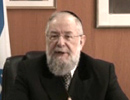Beit Midrash
- Sections
- Chemdat Yamim
- Parashat Hashavua
- Torah Portion and Tanach
- Bereshit
- Vayera
Rashi says that Ma’acha was Nachor and Reuma’s son, but the Seforno claims that she was their daughter. We find the name Ma’acha (which, we will see, does not mean it was the same person), in the genealogy listing in Divrei Hayamim (I, 7:15-16). There Ma’acha is the wife of Machir, grandson of Yosef. This perhaps should not be surprising, since Machir himself was the son of Menashe, son of Yosef, from his "Aramite concubine" (ibid. 14). Thus, it would appear that Machir, who was considered like an Egyptian prince, married a princess from a leading family of Aram.
These types of connections are also hinted at in the genealogical lists in relation to King Shaul, from the Tribe of Binyamin. "In Givon lived the father of Givon, and his wife’s name was Ma’acha. His children were … and Kish … and Kish had Shaul" (ibid. 8:29-33). So Shaul’s grandfather also had a concubine of Aramite descent. The names the pasuk uses also indicate that people from the tribe of Binyamin lived in the Gilad along with the Tribe of Menashe (see ibid. 7:12).
Every time we find the name of a wife and/or noblewoman by the name of Ma’acha, the context is negative. For example, the mother of David’s notorious (for his rebellion against his father) son Avshalom was Ma’acha, and she was the daughter of Talmai the king of Geshur. This was a small Aram-linked kingdom, which was in what is now the Golan Heights. King Aviya the son of King Rechavam came from Ma’acha, the daughter of Avshalom (see Melachim I, 15:2). Aviya was no tzaddik, as he killed 500,000 members of the Israelite kingdom in a fratricidal war (see Divrei Hayamim II, 13:17). The midrash (Vayikra Rabba, Behar 33) even stresses that he did it in a way that the faces of the slain were distorted. The mother of King Assa was also mentioned in a very negative light. She acted in service of the idol Asheira (Divrei Hayamim II, 15:16).
All of these examples strengthen the claim of Seforno that the Ma’acha mentioned in the end of our parasha was the daughter of Reuma, and that this became a popular name for Aramite women of standing. Specifically women of this name entered the Jewish people in an attempt to arrange political treaties, but we see time and again that such attempts to raise the diplomatic profile of the Jewish people had very dangerous consequences. We are thankful that our modern-day Jewish government is able to act to further Israeli diplomatic prominence without resorting to such spiritually dangerous practices as bringing Aramite princesses into our fold.

Parashat Hashavua: From Paroh to Hamas and Iran – In Those Days at this Time
Rabbi Yossef Carmel | Kislev 5786

On Justice and the Right of Appeal – part I
Rabbi Yossef Carmel | 19 Shvat 5784

Parashat Hashavua: “Kings Will Descend from You”
Rabbi Yossef Carmel | Kislev 5786





















